I like Murray Gusseck. I don’t know the guy personally, only his work and reputation. I think he’s brought some interesting concepts to the world of drumline and I like some of the pieces he’s written for battery. I may not always agree with what he teaches, but I respect him and what he’s doing. So make no mistake: what I’m about to write is in no way intended to insult him or make him look bad.
You see, I watched part of the Santa Clara Vanguard audition DVD, namely the Push/Pull exercise, presented by Mr. Gusseck. And, I took some notes because what I observed made me think about a point I’d made in my original post regarding fulcrum theory.
The push/pull technique is a good technique. For me, it’s an alternative technique, and I use a variation of it when I need to accomplish something my default technique would not accomplish as well. Gusseck’s demonstration of his use of this technique was something I was very interested in watching.
He starts by demonstrating the technique with his right hand, holding the stick in a relaxed manner we’ve all come to know: thumb on the side of the stick, fingers gently wrapped around with the index finger across from the thumb. Note that the tip of the index finger is off the stick in a “dangle” position.
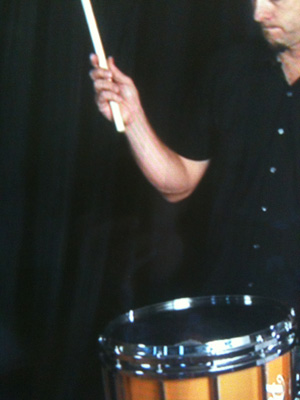
He starts by giving the viewer a stroke-by-stroke demonstration of the technique used to play the exercise, showing the reaction of the stick’s first stroke as it strikes the drumhead. During the downstroke, Gusseck’s thumb moves back so that it is no longer across from his index finger but instead across from his middle finger. Immediately, the stick rebounds and points up (see photo below). As he makes this demonstration, he talks about using the middle finger as the fulcrum. By moving the thumb back so that it is across from the middle finger he does, indeed, create a pivot point.
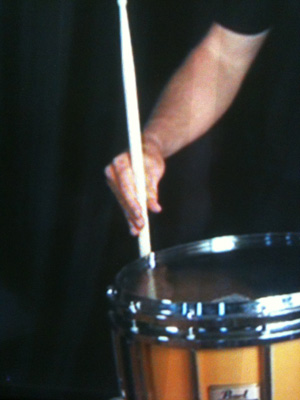
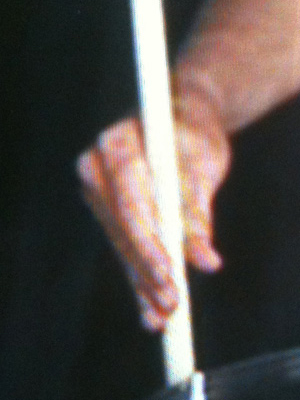
Note how the fingers are in a very straight, pointed position. They’re also all pointed in the same direction, including thumb.
As he “pulls” for the second stroke, the thumb moves back to its original position, across from the index finger. The hand is now around the stick in the original starting grip.
However, when he goes on to demonstrate the full exercise at a regular tempo, his thumb does not move back so that it rests across from the middle finger during the first stroke. Instead, it stays across from his index finger, which is loosely placed around the stick. His stick pivots at this thumb/index finger junction during the exercise. Thus, his fulcrum is not a middle finger-oriented fulcrum, but instead remains with the combination of the thumb and index finger.
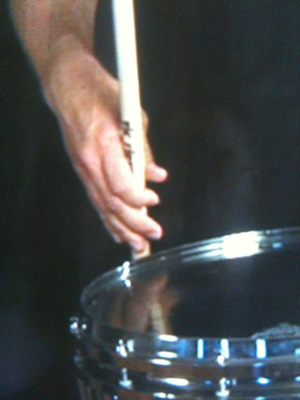
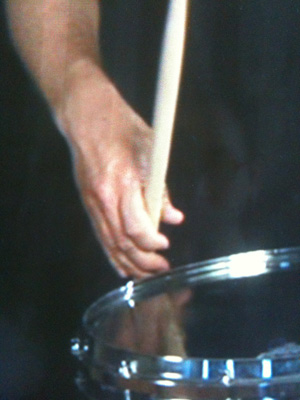
What Gusseck is actually doing is moving the primary leverage control from the index finger to the middle finger by loosening the index finger’s wrap around the stick; you can see the index finger’s tip not in full contact with the stick, in “dangle” position, thus lessening its leverage control. This means the grip is very relaxed and loose. Also note how the position of all the fingers is different from the prior photos that show his stroke-by-stroke demonstration: they’re open but there is a bit of curvature. In the actual application of this exercise, his stroke is different from his demonstration.
As I said at the start of this post, I like Murray Gusseck. There are many things that can be learned from him. In the case of this video performance, however, we learn something different than what he’s telling us. From his physical demonstration of both the stroke-by-stroke example and his full exercise performance, we can extrapolate that the push/pull technique is a perfectly useful technique, but claiming that the technique uses a middle finger fulcrum is not correct. His performance shows us that the middle finger is used as the primary leverage control of the stroke but is not an actual fulcrum itself. Referring to my original essay, a fulcrum is a pivot point, and when the thumb and index finger are in contact with the stick across from each other, no matter how loose the index finger is on the stick, that is the pivot point.
Unfortunately, in this particular case, Gusseck’s vocal information about a “middle finger fulcrum” contradicts what he is playing. This is an important distinction because when instruction clashes with demonstration, students may not learn the correct lesson.
